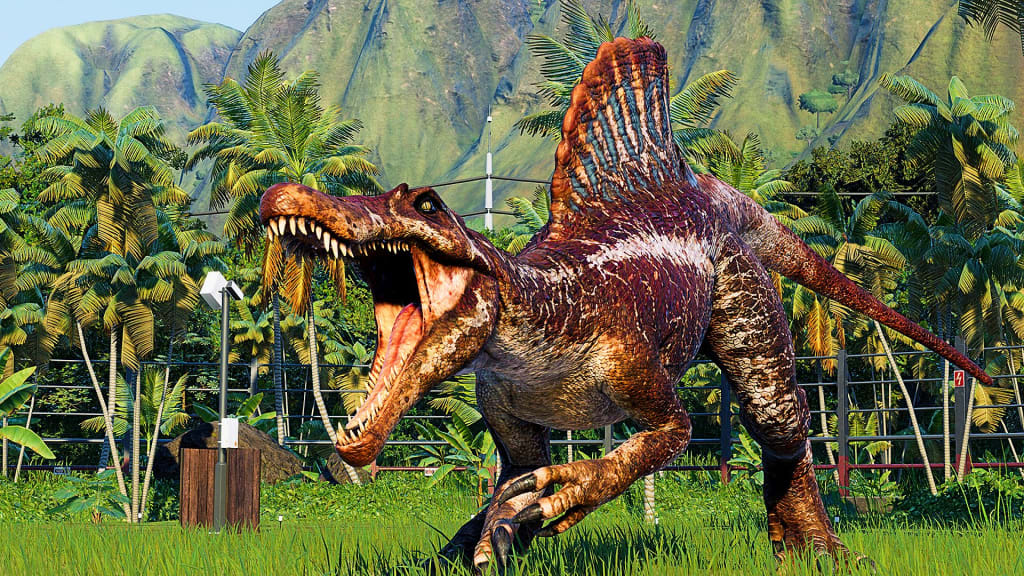Dino Crisis Unleashed: Survival Guide for Human-Dinosaur Coexistence
Navigating Chaos, Identifying Species, and Crafting a Plan to Thrive in the Age of Dinosaurs

Attention, humans, this is not a drill. Dinosaurs have reemerged on our planet and are currently wandering around, causing chaos. The most advanced scientific laboratories are working diligently to comprehend the sudden reappearance, but until we have some answers, here's what you should do. Given that most of us are only familiar with a few select dinosaur species, thanks to Jurassic Park, our first priority is to be able to distinguish between harmless herbivores and carnivorous dinosaurs that pose a threat to us. Being able to make this distinction could potentially save your life.
Let's quickly go over some of the most common herbivores. Make sure to remember at least one defining characteristic of each dinosaur so that you can identify them if you encounter them. For instance, we have the Brachiosaurus, which, despite being non-aggressive, is a colossal 100-foot-long creature that can inadvertently harm you with its tail. While they may appear adorable, please exercise self-control and refrain from attempting to pet them. Then there are the Ankyoceratops and Keyceratops, which resemble rhinoceroses in appearance and stand at approximately human height. Again, petting is off-limits; we're not in a petting zoo here. The Atlasaurus may bear a resemblance to carnivorous dinosaurs, but it is entirely harmless. Although it is incredibly swift, resist the temptation to challenge it to a race. We'll discuss carnivorous dinosaurs shortly.
Before we proceed, it's essential to know what not to do when encountering any of the aforementioned dinosaurs. Under no circumstances should you offer them modern delicacies such as pizza or ice cream. These foods are problematic enough for humans; we don't need larger-than-life creatures suffering from stomachaches. Furthermore, attempting to domesticate them as pets is ill-advised due to their unpredictable behavior. While we have managed to domesticate a line of wolves now known as dogs, it is unlikely that the same approach will be successful with dinosaurs. Also, it might be wise to keep your dogs leashed and consider carrying them in a secure backpack, especially if they are small. If you find yourself in a situation where a dinosaur appears to be approaching you with hostile intent, avoid attempting to scare them off with shiny objects or loud noises. As far as we know, this only agitates and frightens them further.
If you are accustomed to using flashlights, refrain from shining them directly in a dinosaur's face. Similarly, if you possess any devices that produce loud noises and bright lights, it's best to keep them at home. Now that we have covered these precautions, let's move on to the top carnivorous dinosaurs you are most likely to encounter. In these situations, the best course of action is to run for your life. It is highly probable that these dinosaurs are faster than you, so seek shelter indoors where you can lock the doors and remain safe. At the top of our list is the infamous Tyrannosaurus Rex, standing as tall as 12 feet and capable of outrunning you in any scenario. Don't attempt to engage it in basketball, as it is a dinosaur and unfamiliar with the sport. This can quickly escalate into a bloody encounter. Next, we have the Velociraptor, a small but agile creature reminiscent of the one in Jurassic Park. Never attempt to feed it, as you may end up becoming its meal instead. Spinosaurus, while visually stunning with its distinctive back, should be admired from a safe distance. These bipedal dinosaurs can reach up to 60 feet in length, and their teeth are sharp like blades. Exercise caution. Lastly, the Confuciusornis may seem harmless like a bird, but it is incredibly dangerous due to its carnivorous nature. Be cautious as it might try to enter through your window unexpectedly. Consider using arm protection, such as arm sleeves or thick, resistant leather, to prevent possible bites.
Now that we have covered the fundamentals, let's develop an action plan. How will humans coexist with dinosaurs on our now crowded planet? Will we settle for sharing Earth or strive to transport them to another planet? Let's explore the first scenario as an example. We have a few options if we decide to allow dinosaurs to roam freely among us. One possibility is constructing enormous glass domes around cities. These sturdy domes would connect cities via advanced tunnels and suspended highways, effectively separating our day-to-day lives from dinosaur threats. Of course, until we can construct these domes, we would need to limit our time spent outdoors. Traveling by car or plane would be highly discouraged, as cars can be easily destroyed by any major dinosaur species, and planes may encounter flying pterosaurs, which wouldn't be pleasant. Another option is to recruit the strongest and most agile individuals to form a Dino Defense Squad. These brave individuals would be responsible for handling the most formidable dinosaurs during emergencies. However, I personally would not volunteer for such a task.
Additionally, we could consider adopting a Jurassic diet, reminiscent of our ancient ancestors, where we consume raw meat. The idea behind this is to demonstrate to the dinosaurs that we share similarities with them, hoping they will not see us as prey. I hear someone suggesting hamster wheel traps, although it may seem slightly unkind. Humans could construct gigantic hamster wheels to trap dinosaurs, utilizing their movements to generate electricity. This way, they would be stuck in an endless cycle, serving our purposes until they exhaust themselves. Another approach could involve providing each human with a personal hamster ball, ensuring safe mobility in the presence of dinosaur threats. While I acknowledge that these plans are not foolproof, they are worth attempting.
Now, suppose we decide to transport all the dinosaurs to another planet. This plan would require significant technological advancements, including the construction of an enormous fleet of space shuttles capable of carrying these massive creatures. However, capturing all the dinosaurs initially poses a challenge. Here's a wild idea: we could construct a giant magnet to attract all the dinosaurs to a single location. Electromagnetic waves would be responsible for luring the dinosaurs closer to the shuttles. Another approach could involve creating a vast network of trampolines, resembling a real-life game of Frogger. This way, the dinosaurs would bounce their way to the departure station. Alternatively, we could explore the possibility of employing mind games with the dinosaurs. If we could hypnotize them, we might trick each dinosaur into walking willingly to the departure station. A global sound system connected to our existing satellites might enable us to accomplish this. Lastly, we could consider eliminating the most dangerous carnivorous dinosaurs and the excessively large herbivores that unintentionally wreak havoc on our cities. By doing so, we could coexist with some dinosaurs while ensuring our safety.





Comments
Mela Mandigma is not accepting comments at the moment
Want to show your support? Send them a one-off tip.